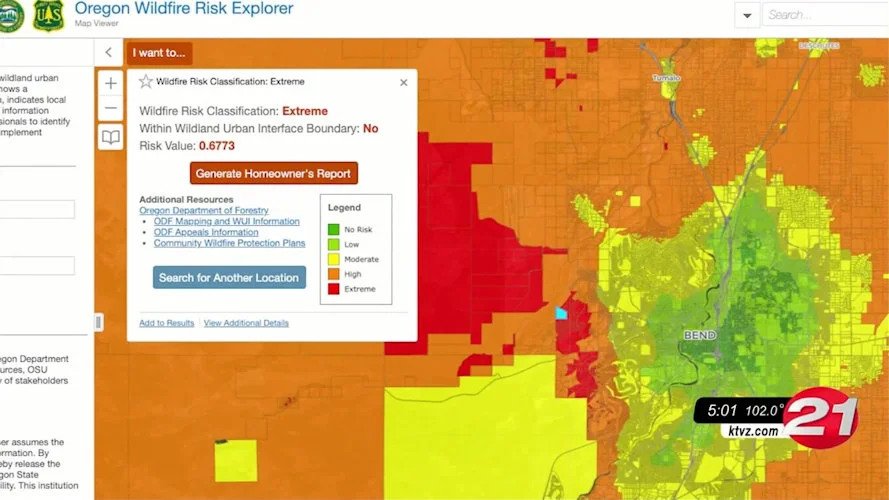Revised version of controversial Oregon wildfire risk map delayed, as lawmakers consider changes

One proposal in Salem would scrap the map entirely
SALEM, Ore. (KTVZ) — The Oregon Legislature will consider a number of recommendations for changes related to the controversial, statewide wildfire risk map during this year's session, some of which would substantively change the map itself. So the release of a revised version has been delayed, officials said Tuesday.
Following conversations last week with the Senate Committee on Natural Resources and Wildfire Programs Advisory Council, the state Department of Forestry said Tuesday it has decided to postpone the release of an updated draft of the map, which was planned for March.
“As we’ve been working with Oregon State University on technical adjustments to the map and planning for community outreach and engagement, we’ve also been keeping a close eye on the policy conversations happening in different venues,” explained Cal Mukumoto, Oregon State Forester and director of the ODF.
“There were some great recommendations that came out of the Wildfire Programs Advisory Council’s first annual report and opportunities identified by Wildfire Programs Director Doug Grafe related to the map that I hope the Legislature gets the opportunity to explore during this session.”
Those recommendations are in addition to several bills proposing a variety of changes, ranging from which areas are assigned a risk classification to abolishing the map entirely.
“We want to avoid expending resources on work that may not align with new direction that may come from the Legislature this session,” Mukumoto said.
Without knowing what decisions will be made by the Legislature, the department does not yet know how long it will take to implement that direction.
Members of both the Senate Committee on Natural Resources and the Wildfire Programs Advisory Council have expressed support for continued mapping of wildfire hazards, to identify where to direct investments in wildfire mitigation activities, including fuels reduction and building defensible space.
“Our goal this session is to get resources and expertise to Oregonians already doing good work on the ground to protect their properties and neighborhoods,” said Sen. Jeff Golden, D-Ashland. Golden chairs the Senate Committee on Natural Resources and was the chief sponsor of SB 762.
“It’s important to get that done and to do all we can to ease the homeowner insurance challenges that the era of megafires has brought us before moving forward with any map,” Golden said.
ODF said there is also broad recognition of the need for increased outreach, education and engagement with communities.
Mark Bennett, chair of the Wildfire Programs Advisory Council, said, “We need an integrated, coordinated and robust communications and outreach effort across all Senate Bill 762 programs to help property owners understand what their classification means, how they can better protect their homes and what resources are available to help them with that work,” said
OSU, ODF’s partner in the development of the map, will lend technical expertise to upcoming educational efforts related to wildfire risk and hazard.
"We are prepared to support state agencies in education plans and will help develop and implement an operational plan as needed,” said Tom DeLuca, dean of OSU’s College of Forestry.
Other state agencies with SB 762 responsibilities that have a nexus to the map are Office of the State Fire Marshal, Department of Consumer and Business Services – Building Codes Division and the Department of Land Conservation and Development.
“The success of this whole program depends on strong collaboration between state government, local leaders and property owners in wildfire-prone areas. Building that partnership has to be job number one over the coming months,” Golden explained. “When we feel like we’re pulling in the same direction, we’ll be ready for a much better conversation about the map.”
While the Legislature is in session, the department said it will:
- Continue to work with OSU on exploring technical adjustments in response to feedback received on the initial map, including concerns related to irrigated lands and classification differences on adjacent lots.
- Follow the progress of bills related to the risk map to plan quickly and appropriately for any rulemaking actions or other activities required to implement new or changed legislative direction.
- Work with the Wildfire Programs Advisory Council to identify community needs and with partner agencies to leverage opportunities for outreach, education and engagement.